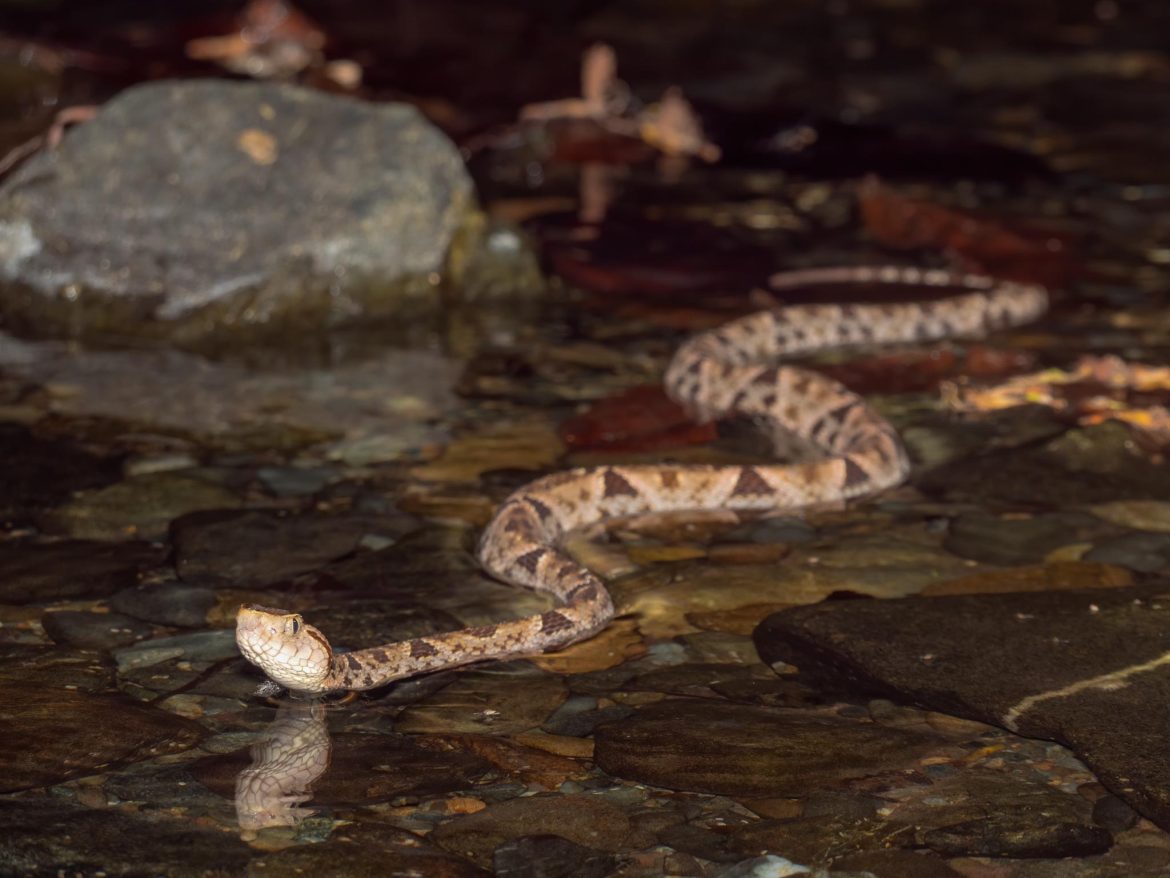Costa Rica, a lush bastion of biodiversity, is not just a paradise for ecotourists and nature lovers but also a land where the line between breathtaking and perilous can be as thin as a vine. Home to an array of creatures ranging from venomous vipers to majestic big cats, the nation’s wildlife is as diverse as it is daunting. Understanding these creatures and the risks they pose is crucial for anyone venturing into this vibrant ecosystem.
Venomous Vipers: A Close Encounter of the Slithery Kind
Among the most feared residents of Costa Rica’s rainforests are its venomous snakes, including the notorious Fer de Lance and the Eye Lash Viper. The Fer de Lance, known locally as ‘Terciopelo’, is particularly formidable. It thrives in the humid, shadowy forests and disturbed habitats like banana plantations, blending into the underbrush with its pale yellow or cream-colored bands crossed with dark diamond patterns. This snake is responsible for the majority of serious snakebite incidents in Costa Rica, delivering a venom potent enough to cause blindness, tissue necrosis, and even death.
The Eye Lash Viper, on the other hand, demands attention for its striking appearance. Named for the horn-shaped extensions above its eyes, this snake exhibits a kaleidoscope of colors from yellow and red to green and brown, making it a deadly beauty that commands respect and caution.
Big Cats: The Stealthy Predators of the Forest
Venturing from the forest floor to the undercanopy, Costa Rica’s big cats such as Jaguars and Pumas epitomize feline power and grace. These predators, solitary and secretive, roam extensively across diverse forest habitats including the protected expanses of Santa Rosa National Park and Arenal Volcano National Park. Encounters with these magnificent animals are rare and awe-inspiring, yet they underscore the critical need for distance and respect to avoid disturbing their natural behaviors.
Tiny But Deadly: The Colorful World of Poison Dart Frogs
Shifting the focus from the large to the diminutive, Costa Rica’s rainforests are also home to the visually stunning yet dangerously toxic Poison Dart Frogs. These small amphibians, no larger than a paperclip, carry toxins potent enough to paralyze or kill. The bright colors of their skin, ranging from vivid blues to radiant reds, serve as a natural warning about the lethal chemicals contained within. Found primarily in the humid lowlands, these frogs are a perfect example of nature’s palette signaling danger.
River Monsters: Navigating the Waters with Crocodiles and Bull Sharks
Costa Rica’s waterways and coastal regions bring us face-to-face with some of the most formidable aquatic predators: the American Crocodile and the Bull Shark. These creatures, while less visible than their terrestrial counterparts, pose significant risks. The American Crocodile, often spotted along the Tarcoles River, can exhibit territorial aggression, especially during nesting season. Bull Sharks, known for their ability to thrive in both salt and freshwater, frequent river mouths and coastal areas, adding an element of surprise and danger to water-based activities.
Coexisting with Costa Rica’s Wildlife: Tips for Safety and Respect
The thrill of encountering such diverse wildlife comes with the responsibility of ensuring personal safety and respecting the natural habitats of these creatures. Key strategies include:
- Maintaining a safe distance: Always keep a respectful distance from wildlife, particularly from animals like Jaguars and venomous snakes.
- Adhering to local guidelines: Follow the instructions of local guides and adhere to park rules designed to protect both visitors and wildlife.
- Using binoculars for observation: Enhance your wildlife viewing experience safely through the use of binoculars or other distance-enhancing tools.
- Avoiding night-time excursions in unfamiliar areas: Many of Costa Rica’s predators are nocturnal and more active at night, making it advisable to avoid wandering in their habitats after dark.
A Delicate Balance Between Beauty and Danger
Navigating the wilds of Costa Rica offers a unique opportunity to witness nature’s complexity and beauty firsthand. However, the presence of dangerous animals necessitates a well-informed approach to exploration. By respecting the natural world and its inhabitants, visitors can enjoy the rich biodiversity of Costa Rica safely and sustainably.
In essence, when trekking through Costa Rica’s verdant landscapes, always remember that awareness, preparation, and respect are your best tools for a safe and enriching experience.

